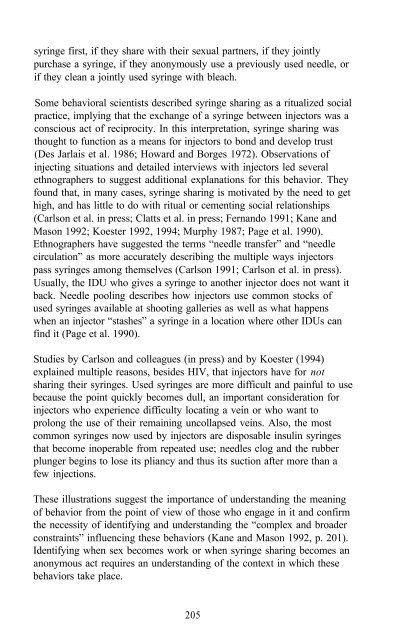The Context of HIV Risk Among Drug Users and Their Sexual Partners
The Context of HIV Risk Among Drug Users and Their Sexual Partners
The Context of HIV Risk Among Drug Users and Their Sexual Partners
You also want an ePaper? Increase the reach of your titles
YUMPU automatically turns print PDFs into web optimized ePapers that Google loves.
syringe first, if they share with their sexual partners, if they jointly<br />
purchase a syringe, if they anonymously use a previously used needle, or<br />
if they clean a jointly used syringe with bleach.<br />
Some behavioral scientists described syringe sharing as a ritualized social<br />
practice, implying that the exchange <strong>of</strong> a syringe between injectors was a<br />
conscious act <strong>of</strong> reciprocity. In this interpretation, syringe sharing was<br />
thought to function as a means for injectors to bond <strong>and</strong> develop trust<br />
(Des Jarlais et al. 1986; Howard <strong>and</strong> Borges 1972). Observations <strong>of</strong><br />
injecting situations <strong>and</strong> detailed interviews with injectors led several<br />
ethnographers to suggest additional explanations for this behavior. <strong>The</strong>y<br />
found that, in many cases, syringe sharing is motivated by the need to get<br />
high, <strong>and</strong> has little to do with ritual or cementing social relationships<br />
(Carlson et al. in press; Clatts et al. in press; Fern<strong>and</strong>o 1991; Kane <strong>and</strong><br />
Mason 1992; Koester 1992, 1994; Murphy 1987; Page et al. 1990).<br />
Ethnographers have suggested the terms “needle transfer” <strong>and</strong> “needle<br />
circulation” as more accurately describing the multiple ways injectors<br />
pass syringes among themselves (Carlson 1991; Carlson et al. in press).<br />
Usually, the IDU who gives a syringe to another injector does not want it<br />
back. Needle pooling describes how injectors use common stocks <strong>of</strong><br />
used syringes available at shooting galleries as well as what happens<br />
when an injector “stashes” a syringe in a location where other IDUs can<br />
find it (Page et al. 1990).<br />
Studies by Carlson <strong>and</strong> colleagues (in press) <strong>and</strong> by Koester (1994)<br />
explained multiple reasons, besides <strong>HIV</strong>, that injectors have for not<br />
sharing their syringes. Used syringes are more difficult <strong>and</strong> painful to use<br />
because the point quickly becomes dull, an important consideration for<br />
injectors who experience difficulty locating a vein or who want to<br />
prolong the use <strong>of</strong> their remaining uncollapsed veins. Also, the most<br />
common syringes now used by injectors are disposable insulin syringes<br />
that become inoperable from repeated use; needles clog <strong>and</strong> the rubber<br />
plunger begins to lose its pliancy <strong>and</strong> thus its suction after more than a<br />
few injections.<br />
<strong>The</strong>se illustrations suggest the importance <strong>of</strong> underst<strong>and</strong>ing the meaning<br />
<strong>of</strong> behavior from the point <strong>of</strong> view <strong>of</strong> those who engage in it <strong>and</strong> confirm<br />
the necessity <strong>of</strong> identifying <strong>and</strong> underst<strong>and</strong>ing the “complex <strong>and</strong> broader<br />
constraints” influencing these behaviors (Kane <strong>and</strong> Mason 1992, p. 201).<br />
Identifying when sex becomes work or when syringe sharing becomes an<br />
anonymous act requires an underst<strong>and</strong>ing <strong>of</strong> the context in which these<br />
behaviors take place.<br />
205
















